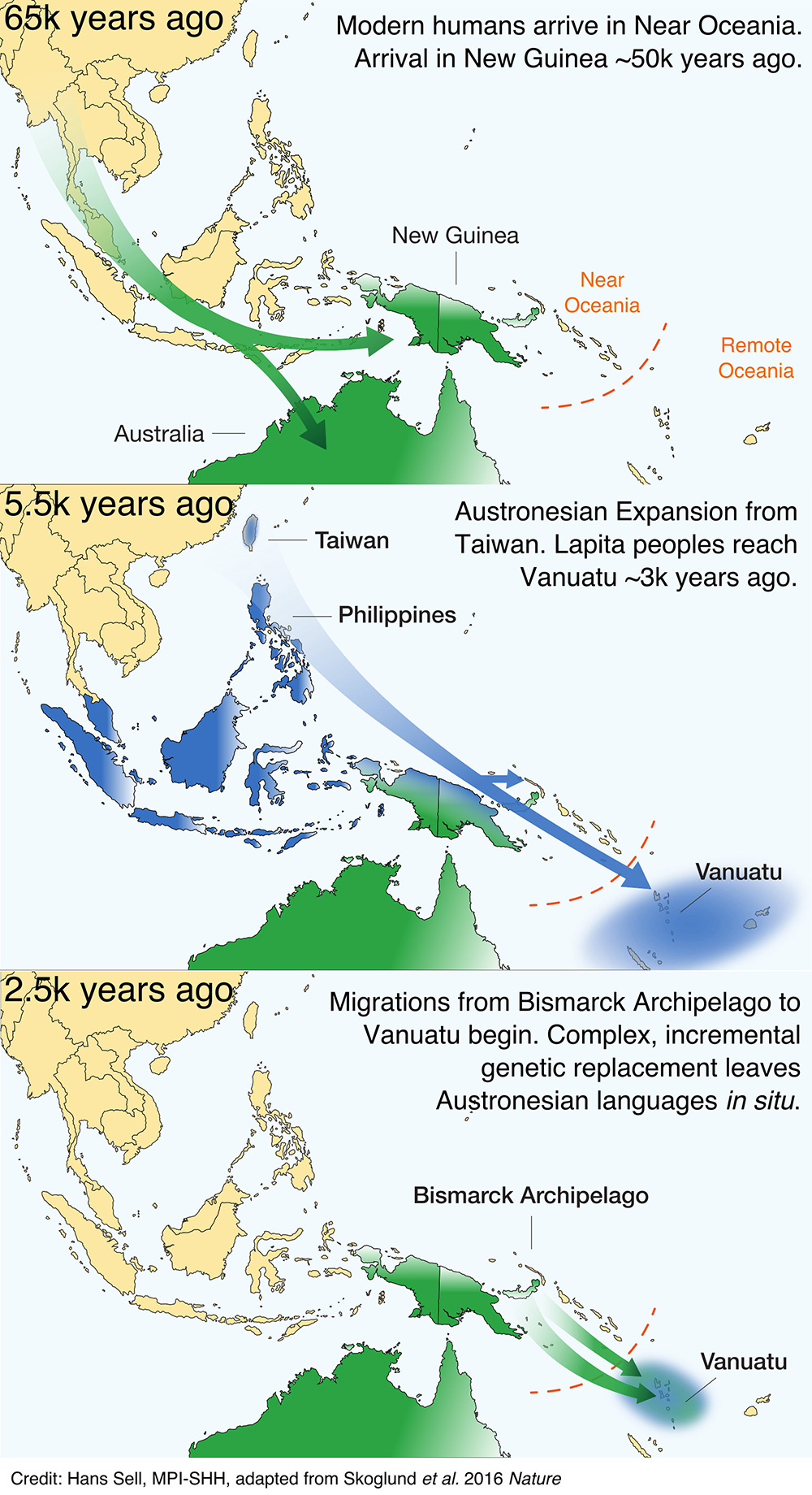New article (behind paywall) Language continuity despite population replacement in Remote Oceania, by Posth et al., Nat. Ecol. Evol. (2018).
Abstract:
Recent genomic analyses show that the earliest peoples reaching Remote Oceania—associated with Austronesian-speaking Lapita culture—were almost completely East Asian, without detectable Papuan ancestry. However, Papuan-related genetic ancestry is found across present-day Pacific populations, indicating that peoples from Near Oceania have played a significant, but largely unknown, ancestral role. Here, new genome-wide data from 19 ancient South Pacific individuals provide direct evidence of a so-far undescribed Papuan expansion into Remote Oceania starting ~2,500 yr BP, far earlier than previously estimated and supporting a model from historical linguistics. New genome-wide data from 27 contemporary ni-Vanuatu demonstrate a subsequent and almost complete replacement of Lapita-Austronesian by Near Oceanian ancestry. Despite this massive demographic change, incoming Papuan languages did not replace Austronesian languages. Population replacement with language continuity is extremely rare—if not unprecedented—in human history. Our analyses show that rather than one large-scale event, the process was incremental and complex, with repeated migrations and sex-biased admixture with peoples from the Bismarck Archipelago.
So, despite the population replacement in Oceania seen recently in Genomics, the people of present-day Vanuatu continue to speak languages descended from those spoken by the initial Austronesian inhabitants, rather than any Papuan language of the incoming migrants.
Professor Gray, Director of the Department of Linguistic and Cultural Evolution at the MPI-SHH, says:
Population replacement with language continuity is extremely rare – if not unprecedented – in human history. The linguist Bob Blust has long argued for a model in which a separate Papuan expansion reaches Vanuatu soon after initial Austronesian settlement, with the initial, and likely undifferentiated, Austronesian language surviving as a lingua franca for diverse Papuan migrant groups.
Dr. Adam Powell, senior author of the study and also of the MPI-SHH, continues,
The demographic history suggested by our ancient DNA analyses provides really strong support for this historical linguistic model, with the early arrival and complex, incremental process of genetic replacement by people from the Bismarck Archipelago. This provides a compelling explanation for the continuity of Austronesian languages despite the almost complete replacement of the initial genetic ancestry of Vanuatu.

I think we can safely disagree now with their assertion. We are seeing more and more cases of language continuity in spite of population replacement quite clearly in Eurasian prehistory. At least:
- In Iberia with continuity of Vasconic despite population replacement after the (Indo-European) Bell Beaker expansion seen recently in Olalde et al. (2018).
- In the North Caspian steppe, with continuity of Indo-Iranian, adopted by the newcomers of late Corded Ware cultures.
- In North-Eastern Europe, after the arrival of haplogroup N1c (potentially of Siberian languages, like Yukaghir), which left intact the (most likely Uralic) languages expanded with Corded Ware migrants.
- In East-Central Europe and Scandinavia, with the “resurge” of typically Corded Ware (R1a) lineages in certain regions, but continuity of Proto-Balto-Slavic and Pre-Germanic, respectively, as seen in the recent Nature (2018) papers, too.
- In Greece, with the “resurge” of typically Minoan (J) lineages and later parcial replacement by other (R1a) lineages, but continuity of Greek languages.
- And more examples, like Palaeo-Balkan languagesin the Balkans with a resurge of older lineages, in Central Asia with the presence of R1a in (probably) Tocharian mummies with an origin in the Afanasevo culture, etc.
All these cases can be explained with founder effects and gradual expansions after an initial arrival, maybe also initial close interaction between different ethnic groups, where one group (and its language) becomes the dominant one.
NOTE. Even if an alternative model is selected (say, that Corded Ware migrants spoke Indo-European languages), alternative language continuity events need to be proposed for some of these regions, so we are beyond their description as ‘rare language events’ already.
What is becoming clearer with ancient samples, therefore, is that there is little space for prehistoric cultural diffusion events (at least massive ones), which were quite popular explanations before the advent of genetic studies.
Related:
- Consequences of O&M 2018 (I): The latest West Yamna “outlier”
- Olalde et al. and Mathieson et al. (Nature 2018): R1b-L23 dominates Bell Beaker and Yamna, R1a-M417 resurges in East-Central Europe during the Bronze Age
- The Indo-European demic diffusion model, and the “R1b – Indo-European” association
- The concept of “Outlier” in Human Ancestry (III): Late Neolithic samples from the Baltic region and origins of the Corded Ware culture
- More evidence on the recent arrival of haplogroup N and gradual replacement of R1a lineages in North-Eastern Europe
- Analysis of R1b-DF27 haplogroups in modern populations adds new information that contrasts with ‘steppe admixture’ results